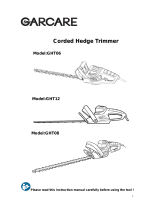
6
e. Maintain power tools. Check for misalignment or
binding of moving parts, breakage of parts and any
other condition that may affect the power tools
operation. If damaged, have the power tool repaired
before use. Many accidents are caused by poorly
maintained power tools.
f. Keep cutting tools sharp and clean. Properly
maintained cutting tools with sharp cutting edges are less
likely to bind and are easier to control.
g. Use the power tool, accessories and tool bits etc. in
accordance with these instructions, taking into
account the working conditions and the work to be
performed. Use of the power tool for operations different
from those intended could result in a hazardous situation.
5. Battery tool use and care
a. Recharge only with the charger specied by the
manufacturer. A charger that is suitable for one type of
battery pack may create a risk of re when used with
another battery pack.
b. Use power tools only with specically designated
battery packs. Use of any other battery packs may create
a risk of injury and re.
c. When battery pack is not in use, keep it away from
other metal objects, like paper clips, coins, keys,
nails, screws, or other small metal objects, that can
make a connection from one terminal to another.
Shorting the battery terminals together may cause burns
or a re.
d. Under abusive conditions, liquid may be ejected from
the battery; avoid contact. If contact accidentally
occurs, ush with water. If liquid contacts eyes,
additionally seek medical help. Liquid ejected from the
battery may cause irritation or burns.
6. Service
a. Have your power tool serviced by a qualied repair
person using only identical replacement parts. This will
ensure that the safety of the power tool is maintained.
Additional power tool safety warnings
@
Warning! Additional safety warnings for hedge
trimmers
u Keep all parts of the body away from the cutter blade.
Do not remove cut material or hold material to be cut
when blades are moving. Make sure the switch is off
when clearing jammed material. A moment of inattention
while operating the tool can result in serious personal
injury.
u Carry the hedge trimmer by the handle with the cutter
blade stopped. When transporting or storing the
hedge trimmer always t the cutting device cover.
Proper handling of the hedge trimmer will reduce possible
personal injury from the cutter blades.
u Keep cable away from cutting area. During operation
the cable can be hidden in shrubs and can be accidentally
cut the handle.
u This tool is not intended for use by persons (including
children) with reduced physical, sensory or mental
capabilities, or lack of experience and knowledge, unless
they have been given supervision or instruction
concerning use of the tool by a person responsible for
their safety. Children should be supervised to ensure that
they do not play with the tool.
u The intended use is described in this instruction manual.
The use of any accessory or attachment or performance
of any operation with this tool other than those
recommended in this instruction manual can present a risk
of personal injury and/or damage to property.
u Do not carry the tool with your hands on the front handle,
switch or the trigger switch unless the battery has been
removed.
u If you have not used a hedge trimmer before, preferably
seek practical instruction by an experienced user in
addition to studying this manual.
u Never touch the blades while the tool is running.
u Never attempt to force the blades to come to a standstill.
u Do not put the tool down until the blades have come to a
complete standstill.
u Regularly check the blades for damage and wear. Do not
use the tool when the blades are damaged.
u Take care to avoid hard objects (e.g. metal wire, railings)
when trimming. Should you accidentally hit any such
object, immediately switch the tool off and check for any
damage.
u Should the tool start to vibrate abnormally, immediately
switch it off and check for any damage.
u If the tool stalls, immediately switch it off. Remove the
battery before attempting to remove any obstructions.
u After use, place the blade sheath supplied over the
blades. Store the tool, making sure that the blade is not
exposed.
u Always ensure that all guards are tted when using the
tool. Never attempt to use an incomplete tool or a tool with
unauthorised modications.
u Never allow children to use the tool.
u Be aware of falling debris when cutting the higher slides of
a hedge.
u Always hold the tool with both hands and by the handles
provided.
u Check the hedge for foreign objects, e.g. wire fences.

















